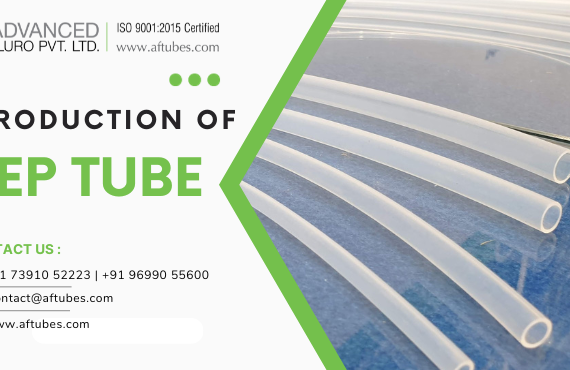FEP Tubing Properties and Applications
What is FEP?
FEP stands for Fluorinated ethylene propylene, it is a fluoropolymer made from synthesis of hexafluoropropylene and tetrafluoroethylene. FEP can be melt extruded to manufacture FEP tubes. It’s transparent and are chemically very non reactive. They also posses excellent electrical properties.
Applications and properties of FEP Tubing in Different Industries
FEP Tubing in the Pharmaceutical Industry
In the pharmaceutical industry, transportation of fluids requires high levels of infertility, accurate flow control, and low risk of contamination and compatibility with various drugs. These requirements are often met by special equipment such as biocompatible materials that comply with diagram pumps, interlocking pumps, disposable systems and strict regulatory standards. It is important to maintain the integrity of the fluid in the entire production process. FEP tubes are an ideal choice for Pharma applications as they conform to food grade test standard, are transparent and offer flexibility so they can routed in tight spaces.
FEP Tubing in the Semiconductor Industry
Critical Requirements for Fluid Transportation
In the semiconductor industry of the fluid transportation system, it is necessary to comply with strict requirements focused on the provision of ultra -ionized liquids such as ultra -ionized water such as minimum pollution, constant flow rate and accurate pressure control. Even fine impurities can greatly affect the quality of the production semiconductor chip. To do this, special materials, design functions and monitoring systems are required to maintain the integrity of the liquid throughout the process.
Main requirements for fluid transportation in semiconductor production:
Very high cleanliness: Liquids should be very clean, often 18.2 mî © -cm water specific resistance, minimal dissolved particles, ions and organic contaminants.
Material compatibility: Tubing, Pipelines and fitting should be made of materials resistant to chemical reactions with used liquids, including high -end stainless steel, PTFE, FEP, PFA and special processing polymer.
Internal surface: To minimize particle adhesion and turbulence flow, the inside of the FEP tubing & pipeline must be smooth and polished.
Minimal dead legs: The design of the FEP tubing should avoid unnecessary bent and dead spaces where contaminants can accumulate.
Accurate stream control: The correct adjustment of the flow rate in FEP tubing is important for various processes such as cleaning plates and chemical etching.
Pressure stability: Consistent pressure of the FEP tubing is important for maintaining the stability of the process.
Leak detection and prevention: A detection system is required to identify and prevent leakage of potential pollution that can endanger the purity of the fluid.
Temperature control: Depending on the process, accurate control of the temperature of the liquid may be required.
FEP Tubing in Analytical Equipment
Strict Requirements for Fluid Handling
there are strict requirements for accuracy, minimum pollution, compatibility with extensive chemicals, consistent flow rates, leaks and small quantities of samples. For example, we analyze all of this while maintaining sterilization in the field of life science or in the application field required in pharmaceutical analysis.
Main aspects of fluid transportation in analytical equipment:
Material compatibility: Selection of pipes and fittings made of chemically resistant -resistant materials for analysis used for analysis such as PTFE (TEFLON), FEP (TEFLON) & PFA (TEFLON) PEEK, or Stainless Steel is important to prevent the contamination and decomposition of samples.
Low dead volume: To minimize the loss of samples and provide accurate results, the FEP tubing requires a minimum internal volume in tubes, connectors and valves, especially when working with small sample sizes.
Accurate stream control: Achieve consistent delivery and reliable analysis results by using a syringe pump, interlocking pump, or microfluidic system with FEP tubing, enabling precise flow rate.
Technology Connection: All compounds in the fluid transportation system must be resistant to leaks to prevent sample loss and potential pollution risk.
Steamed method: In the case of applications that require sterilization, It will be suited for processing and sterilization procedures, including disposable components or the use of selected purified protocols.
Minimum transmission: In particular, when using various samples or analysis water, the FEP tubing must be developed to minimize the residual delivery of the analysis samples.
Automation Compatibility: It is often required to integrate with the automatic processing system of the sample, and requires compatibility between the mechanism of the robot hand and the sample load.
Specific consideration of fluid transportation according to analysis technology:
Chromatography: Accurate stream control, optimal separation and analysis requires a small amount of dead quantity and various mobility and compatibility with various mobile stages.
Mass -electronic measurement: High vacuum compatibility, minimum evaporation and accurate introduction of samples are important for accurate analysis of mass.
Spectroscopy: Responding consideration of light paths for consistent sample delivery, minimum bubbles and optimal signal detection.
Given all the above requirements of various industries, FEP tubing is perfectly suited and hence an ideal choice of tubing.








